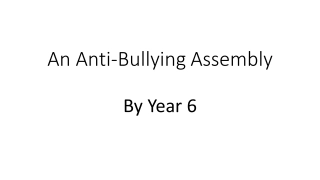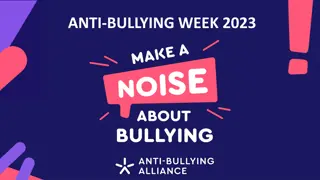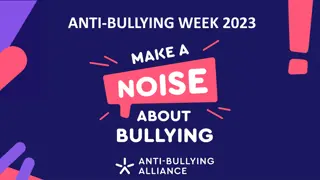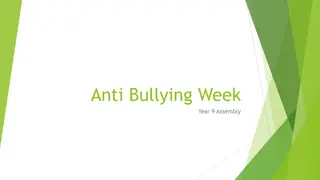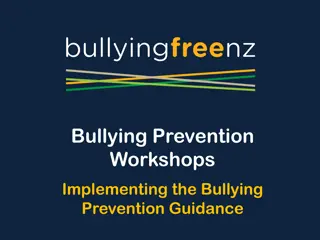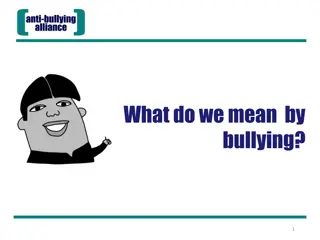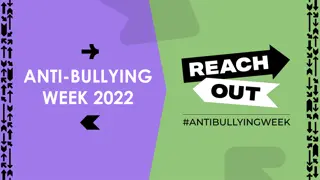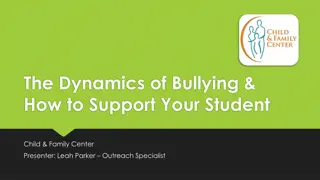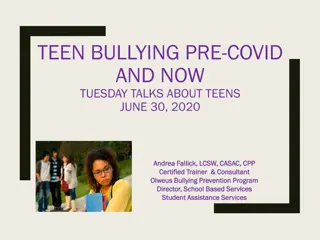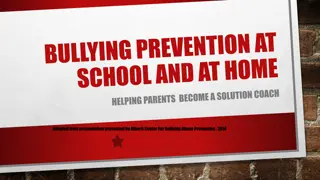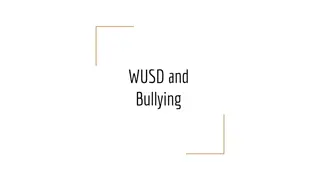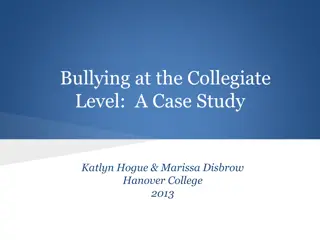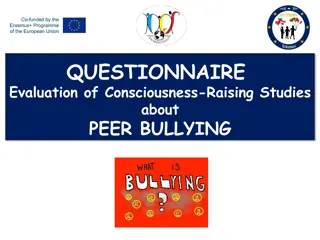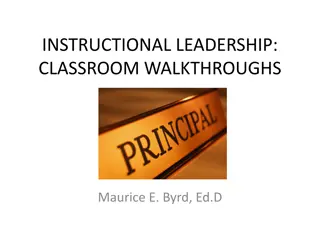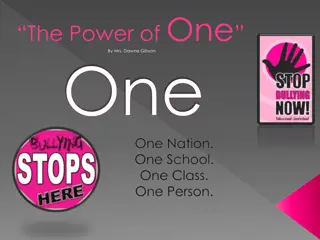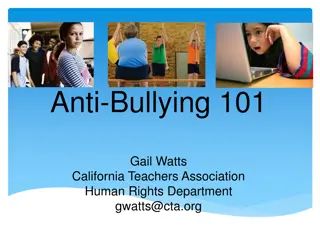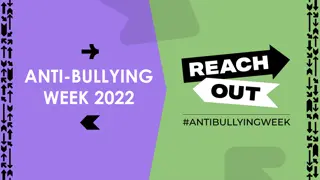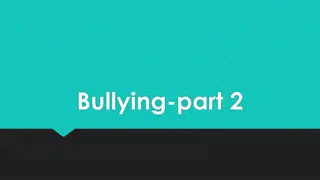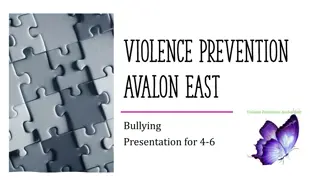Integrating Classroom Bullying into Instructional Practices: Workshop Insights
Explore the landscape of classroom bullying and its integration into educational practices. Define bullying behavior, understand its various forms, and discover ways to address bullying in communication courses. Consider the role of power dynamics and ethical implications while reviewing intervention models for K-12 settings.
- Bullying Education
- Instructional Practices
- Communication Courses
- Workshop Insights
- Classroom Dynamics
Download Presentation

Please find below an Image/Link to download the presentation.
The content on the website is provided AS IS for your information and personal use only. It may not be sold, licensed, or shared on other websites without obtaining consent from the author. Download presentation by click this link. If you encounter any issues during the download, it is possible that the publisher has removed the file from their server.
E N D
Presentation Transcript
Integrating Classroom Bullying into Instructional Practices Sally Vogl-Bauer, PhD Cathy Gillotti, PhD NCA 2016 Short Course Philadelphia, PA
Goals of Todays Workshop O First Half of Workshop O To identify opportunities to integrate bullying concepts in course curricula O To explore ways to converge NCA s Core Competencies with bullying concepts O To provide tools for applying bullying concepts into the classroom O Second Half of Workshop O To review K-12 intervention models and best practices O To explore the role of classroom, department, and institution culture in the approach institutions take to bullying
Bullying Defined Bullying behavior is defined as the subjecting of a victim O to repeated negative actions O intended to cause discomfort or injury O over an extended duration of time O by a perpetrator who holds real or perceived advantage in physical, psychological, or social power over the victim (Elpus & Carter, 2016).
The Bullying Landscape in Education In an attempt to understand bullying better, it is also important to remember that: Bullying takes many different forms Bullies may or may not know their targets You don t have to be weak to be the target of bullying Determining the role of power can be complicated
Making Bullying Relevant in Communication Courses There are many logical links and associations that can be made: O Bullying entails both verbal and nonverbal messages O Bullying is an interpersonal communication activity O Bullying involves the use or abuse of power O Bullying has ethical implications
Here are some additional things to think about O What aspect of bullying do you want to address? O How much time do you have to dedicate to the subject? O How would this content support course learning outcomes?
Curricular Options O Freshman Experience Course (FYE) O Your Institution s Basic Course O Interpersonal Communication O Small Group Communication O Dark Side of Interpersonal Communication O Conflict & Negotiation O Organizational Communication O Communication & Social Media
Integrating NCAs Core Competencies with Bullying Concepts Monitoring and Presenting Your Self 1. 2. Practicing Communication Ethics 3. Adapting to Others 4. Practicing Effective Listening 5. Expressing Messages 6. Identifying and Explaining Fundamental Communication Processes 7. Creating and Analyzing Message Strategies
Applying Bullying Concepts into the Classroom O Sticks & Stones www.tolerance.org O Uppers/Downers/Vultures Wood (2004) O Buckets of Water/Candy O Internal Monologue Wood (2004)
A Review of K-12 Intervention Models & Best Practices O Vreeman & Carroll (2007) did a meta- analysis of K-12 intervention programs O 5 categories of programs include: O Curriculum interventions O Multi-disciplinary/whole school O Targeted social/behavioral skills O Mentoring O Increased social work support
Curriculum Interventions O Curricular interventions included things such as videotapes, lectures, and/or written curriculum which varied in intensity from a single videotape viewing followed by class discussion to a 15-week module O Results showed that these programs did not consistently decrease bullying (Vreeman & Carroll, 2007)
Whole-School Interventions O Whole-school interventions included a combination of school-wide rules and sanctions, teacher training, classroom curriculum, conflict resolution, and individual counseling. O Overall, studies showed positive effect on a reduction in bullying when whole-school interventions were implemented. (Vreeman & Carroll, 2007)
Additional Whole-School Intervention Findings O The Olweus Bullying Prevention Program has reported 30-70% reductions in student reports of bullying, and has been the model from which other programs have been tailored. O However Vreeman & Carroll (2007) found two studies with disparate results in evaluation of this program both in Norway.
Bottom Line from Vreeman & Carroll (2007) O In conclusion, fairly consistent evidence suggests that children s bullying behavior can be significantly reduced by well-planned interventions (p.87). Image by www.stopbullying.org
Role of Teacher O Veenstra, Lindenberg, Huitsing, Sainio, & Salmivalli (2014) conducted a study of 2,776 4th- 6thgraders and found that students perceptions of their teachers efficacy in decreasing bullying was related to lower levels of peer-related bullying. O This study was based on Goal-Framing Theory. O This theory notes that goals that are focused on the way one feels (like gaining status and affection) can be inhibited by the activation of the over- arching goal to act socially appropriately in a particular situation (p. 1136).
An Elephant in the Living Room? O Cultural environments often determine the extent to which bullying behaviors are: O Explicitly discouraged and addressed O Implicitly discouraged and addressed O Explicitly encouraged O Implicitly encouraged
Classroom Environments O Student Behaviors: O Is the bully aware of what he/she is doing? O Is the target aware of what is going on? O Are other students aware of what is going on? O How are the students responding? O Instructor Behaviors: O Is the instructor aware of what is going on between students? O Is the instructor aware of what is going on between them and their students? O How is the instructor responding?
Department Culture O What are the department norms and rules associated with incivility? O What types of behaviors are encouraged vs. discouraged? O What types of behaviors are enabled vs. empowered? O Does the department have any formal policies addressing classroom bullying? O How does the department handle issues related to other types of bullying that may be taking place within the department?
Institutional Culture O What does the Student Handbook say about bullying and incivility? O What do the Faculty Personnel Rules say about bullying and incivility? O Are there any problematic behaviors that are either explicitly or implicitly ignored? O In either instance, where is the burden of proof?
Institutional Procedures O Purdue University Northwest O Report an incident/person of concern form O www.pnw.edu/dean-of-students/ O Explained in TA training
Safe Zone O The Safe Zone program aims to create a visible network of support for LGBTQ individuals and their allies by providing an avenue through which any member of the Purdue University Northwest Community can show their support. The program also creates an educational experience through the Safe Zone Workshop. O The Safe Zone program encourages student, faculty, and staff to explore cultural identity, values, and stereotypes in order to better understand how these issues impact the university, surrounding community and LGBTQ communities.
Step Up! Bystander Intervention O You can actively help prevent incidents before they occur and help to keep your friends safe. Purdue University Northwest Step UP! program which was developed by the University of Arizona and the NCAA raises awareness, provides skills and educates people to recognize the continuum of violence. O Through training bystander intervention empowers and mobilizes participants to recognize, intervene, prevent and/or stop inappropriate comments, actions and behaviors. The entire campus community plays a valuable role in preventing acts that violate the basic dignity of an individual.
Were all just walking each other home. Ram Dass
References O Brown, B. (2015). Rising strong: The reckoning, the rumble, the revolution. New York: Spiegel and Grau. O Coopman, S.J. & Wood, J.T. (2004). Instructors manual for Wood s Interpersonal communication: Everyday encounters. Belmont, CA: Wadsworth/Thomon Learning. O Elpus, K. & Carter, B.A. (2016). Bullying victimization among music ensemble and theatre students in the United States. Journal of Research in Music Education, 64) O Hanh, T.N. (2013). The art of communicating. New York, NY: Harper Collins.
References Valenzano, J.M., Broeckelman-Post, M.A., Parcell, E.S. (2016). Communication pathways. Southlake, TX: Foutainhead Press. O Veenstra, R., Lindenberg, S., Huitsing, G., Sainio, M., & Salmivalli, C. (2014). The role of teachers in bullying: The relation between anti-bullying attitudes, efficacy, and efforts to reduce bullying. Journal of Educational Psychology, 106. 1135- 1143. O Vreeman, R.C. & Carroll, A.E. (2007). A systematic review of school-based interventions to prevent bullying. Archives of Pediatric Medicine, 161, 78-88. O www.pnw.edu O www.stopbullying.org O www.tolerance.org O


